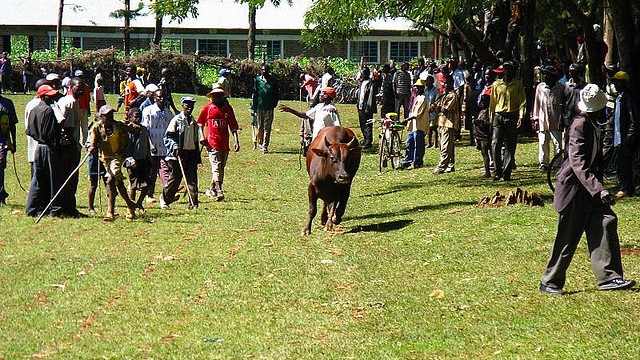Bullfighting is a highly popular sport in Mexico, Spain and parts of Columbia. In this sport, heroic matadors are placed in an arena to battle it out against rowdy bulls.
But in Kakamega County of Western Kenya, the sport takes a whole different dimension – bulls are not pitted against matadors, but against fellow bulls.
The bulls are given intriguing names and it is not uncommon to find bulls with names from Hollywood folklore like ‘Rambo’ or those named after professional wrestlers like ‘Undertaker.’
In 2012, at the height of the U.S. presidential campaigns, ‘Romney’ squared it off against ‘Obama’ in an ironic duel.
The show takes place during national public holidays and on specific Saturdays of the month. Designated duel zones usually are school playing grounds or underdeveloped football stadia that have dusty pitches and sloped hills for seating terraces.
But the audience does not require seats. Chanting traditional war songs and poking the air above them with twigs, the residents look on as a choice bull from one village locks horns with the bravest from an “opposing” village.
The bulls involved are bred specifically for this purpose, fattened for their day of glory. Before the day of the fight, the bulls are fed with a concoction of busaa – a local homemade beer – that is believed to make them more charged.
More brutal bulls take in a whiff or two of marijuana (weed) hours before their fight. It is believed they are more savage after smoking the herb!
The owners speak – in the literal sense – to the bulls to prepare them for battle like gallant gladiators just before being led to the arena.
We hardly ever see the blasts of hot air gushing out of the bulls’ flaring nostrils, as Hollywood depicts but what there is, is an eerie tension before the bulls’ crania collide.
After a chaotic few minutes in the arena, one bull overpowers the other sending him scampering for safety. When the dust settles, the owner of the losing bull parts with a cash amount that had been agreed on before the bout and the owner of the champion bull is a few shillings richer. The champion bull is escorted back to his home village accompanied by an elated crowd now chanting victory songs.
While this is an entertaining sport, little has been done to make it a spectacle of the caliber of a tourist attraction. A pure loss if you ask me.
Bullfighting in Kakamega is an aspect of the local community’s culture that has been carried on for years. It is only recently that the spectacle gained popularity as a tourist attraction.
Government support has been forthcoming, albeit in small bits. In 2013, the government of Kenya provided KES 12.5 million ($147,000) for construction of a bullfighting stadium.
Dr Bonny Khalwalwe, the senator of Kakamega County, has been vocal in the support of the sport. He is an ardent fan of the sport and owns a couple of bulls himself.
On the downside though, the culture has faced opposition by animal rights activists. Due to this, some measures were put in place for treatment of bulls injured during fights. In 2008, an attempt to move the event from Western Kenya to the country’s capital city of Nairobi was met with resistance by locals.
Despite all these challenges, bullfighting continues to play an integral socio-cultural role in the communities around Kakamega. The spectacle continues to rake in lots of money for residents, in form of prize-money and sponsorships. These events have been used by politicians as points of rallying their supporters.
With local and foreign visitors curious to witness the fascinating culture, bullfighting stands out as a unique tourist attraction in Western Kenya.

